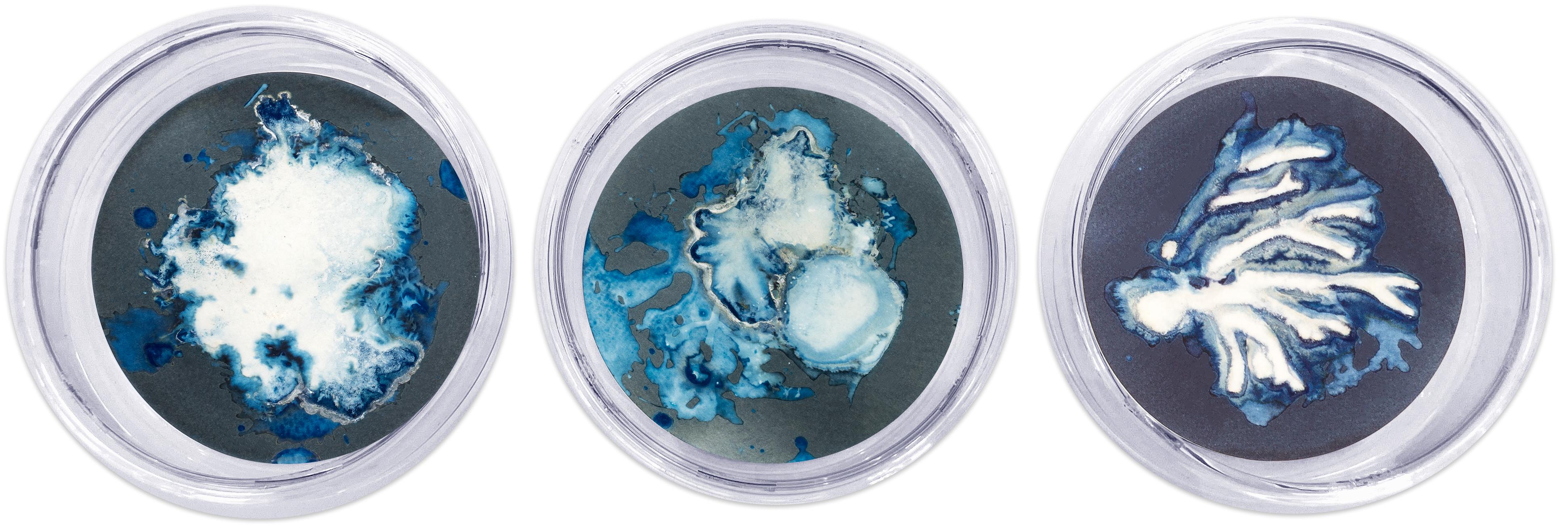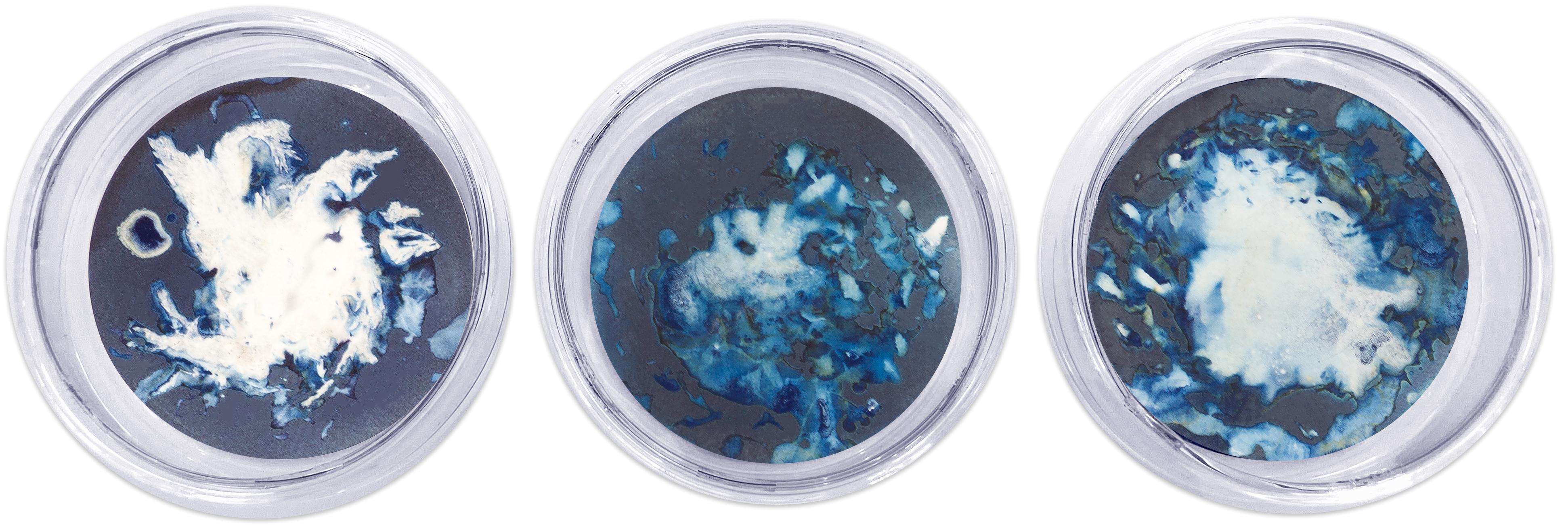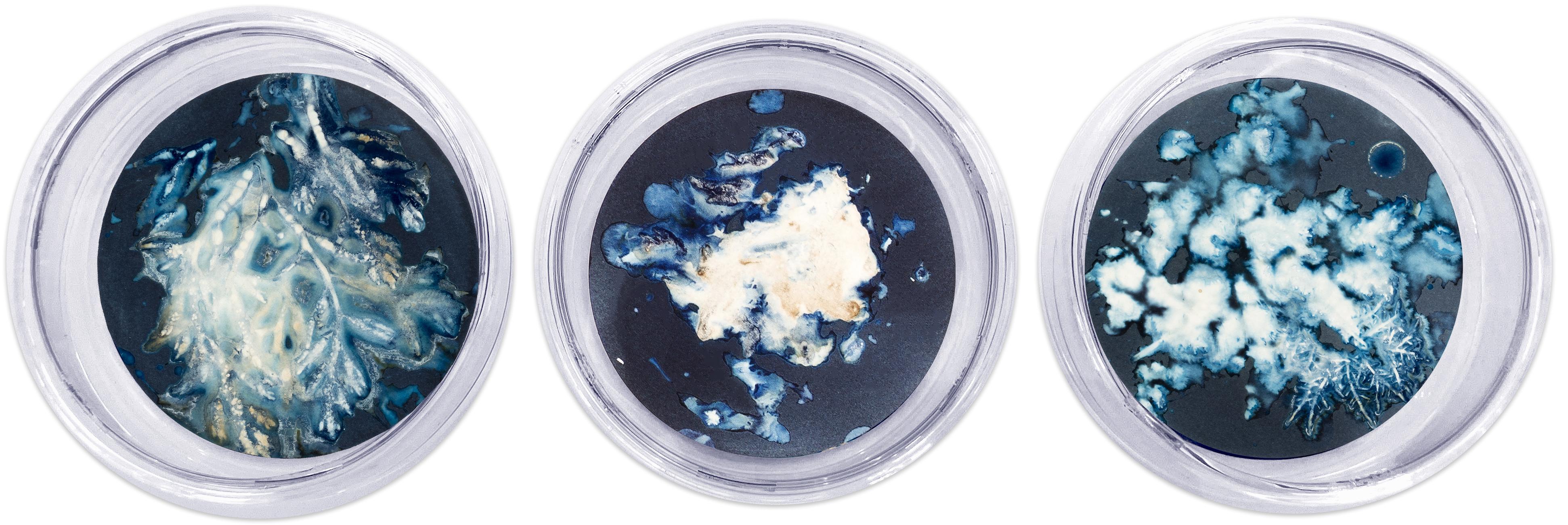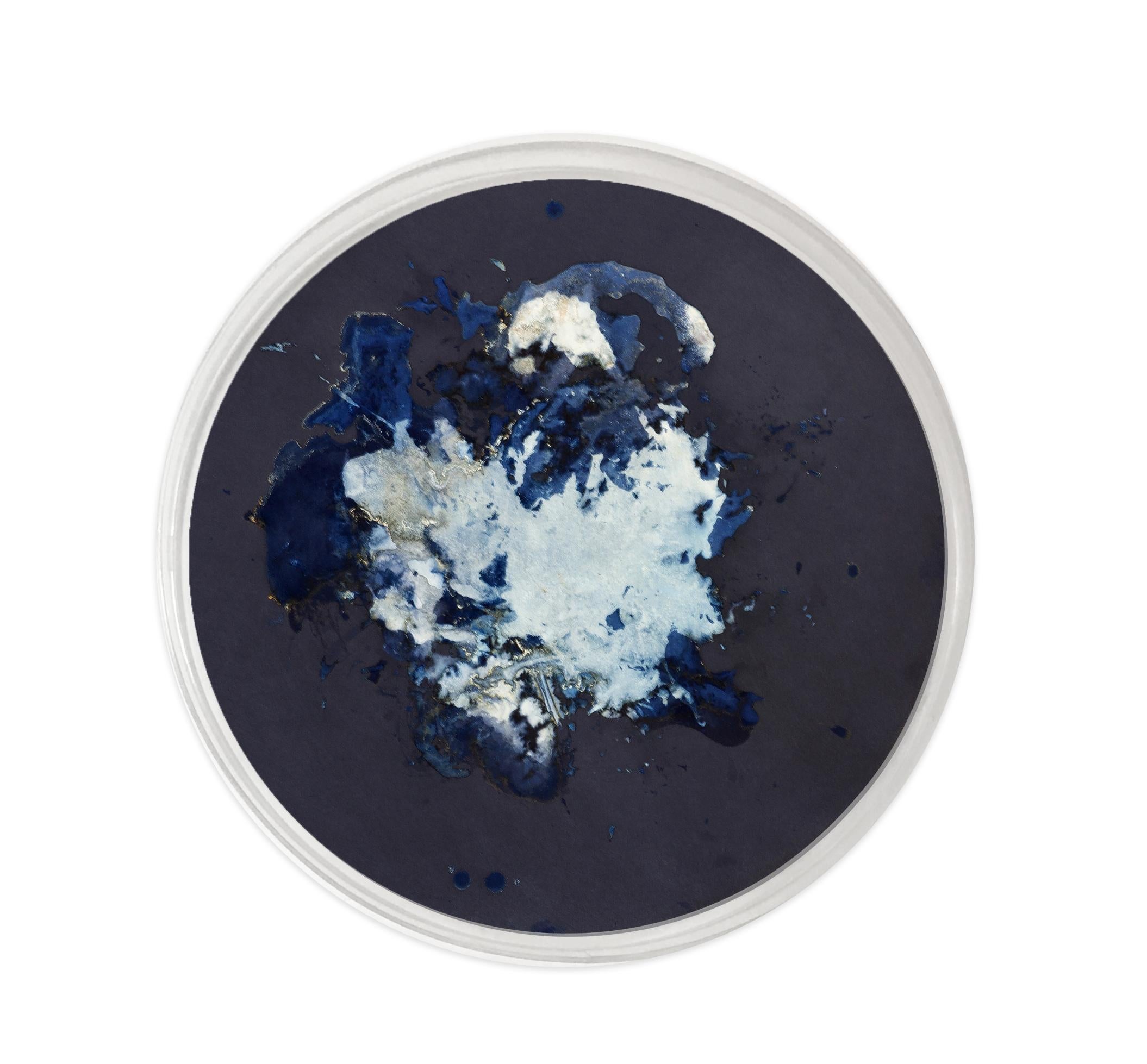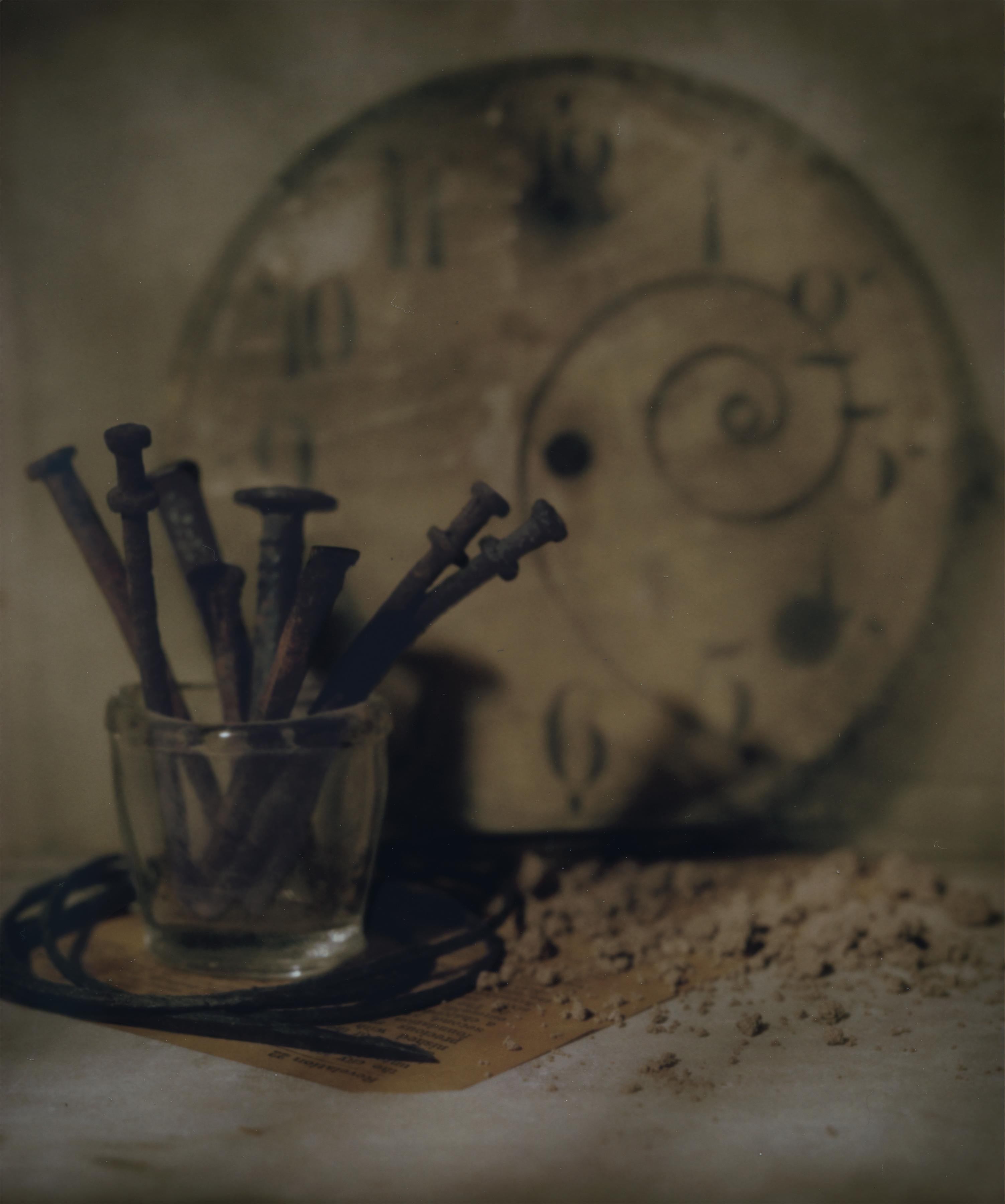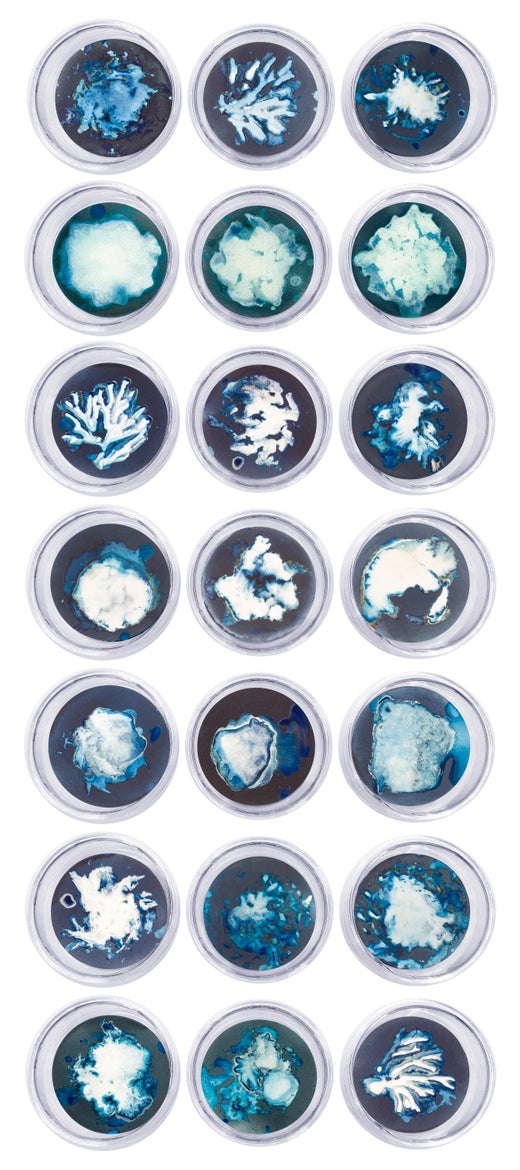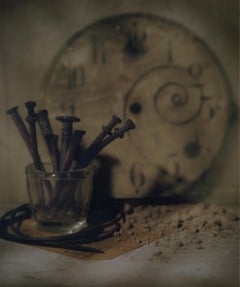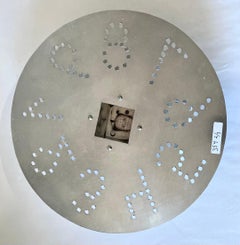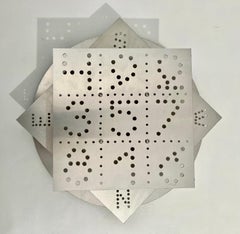Items Similar to Algas 14, 41 y 68. Cyanotype photograhs mounted in high resistance glass dish
Want more images or videos?
Request additional images or videos from the seller
1 of 10
Paola DavilaAlgas 14, 41 y 68. Cyanotype photograhs mounted in high resistance glass dish2022
2022
About the Item
Algas 14, 41 y 68, 2022 by Paola Davila
From the series Mareas
Cyanotype on 300 gr cotton paper
Mounted in a high-resistance borosilicate glass petri dish
Overall size: 36 cm Dm x 12 cm H x 2.4 cm Deep.
Individual Image size: 10.5 cm D.
Each Petri dish: 12 cm Dm. x 2.4 cm Deep.
Unique
The title of each piece corresponds to the geographical coordinates of the place where the pieces were made. The last number indicates the number of waves the paper received.
The piece is protected in an acid-free PH-neutral glassine paper envelope, archival quality.
-------------------------------------
For several years the artist Paola Davila has generated various visual statements from photography. Beyond the self-imposed limits in thematic terms (the house, for example), this exercise has allowed him to articulate concerns and situate spaces: inside, outside, and the limits between one and the other. From there, with the landscape as support: as an extension of situations contained in intimacy or in the object, it has insisted on making its way within other thematic and media fields to different complexities of the idea of also inhabiting the public and finding a voice own in the contemporary photographic narrative.
- Creator:Paola Davila (1980, Mexican)
- Creation Year:2022
- Dimensions:Height: 4.73 in (12 cm)Diameter: 14.18 in (36 cm)
- Medium:
- Movement & Style:
- Period:
- Condition:
- Gallery Location:Miami Beach, FL
- Reference Number:1stDibs: LU453311872882
Paola Davila
Paola Davila, was born in Oaxaca, Mexico, on October 26, 1980. She studied Visual Arts at the National School of Plastic Arts of Mexico, where she attended the contemporary painting seminar taught by maestro Ignacio Salazar. In addition to taking various theory and photography workshops. In 2002, he received the National Photography Prize of the Yucatan Visual Arts Biennial, the Acquisition Prize of the Fourth Art Freedom Contest, and the Young Creators FOECA state scholarship by the state of Oaxaca. It has nine individual exhibitions and more than 30 collective exhibitions both in Mexico and abroad. In 2010, he received the Tierney Grant awarded by the Tierney Foundation of New York by the Manuel Álvarez Bravo Photographic Center to carry out the Temporary Interiors project. She has been a beneficiary of the Young Creators Program, FONCA in 2003, 2006, and 2011. In 2014 she received the Scholarship for Artistic Exchanges and Residencies, FONCA-Land Salzburg of Austria, thanks to which she developed the Schrebergarten project. In 2017 the City of Oaxaca awarded her the degree of Distinguished Citizen, in recognition of her artistic career. In 2019 he obtained a Master's degree in Visual Arts from UNAM with an honorable mention. In 2021 he obtains the acquisition prize at the XIX National Photography Biennial, organized by the Image Center. Since 2020 he is a member of the National System of Art Creators, FONCA, CONACULTA.
About the Seller
4.9
Recognized Seller
These prestigious sellers are industry leaders and represent the highest echelon for item quality and design.
Established in 2000
1stDibs seller since 2016
257 sales on 1stDibs
Typical response time: 6 hours
- ShippingRetrieving quote...Shipping from: Coyoacán, Mexico
- Return Policy
Authenticity Guarantee
In the unlikely event there’s an issue with an item’s authenticity, contact us within 1 year for a full refund. DetailsMoney-Back Guarantee
If your item is not as described, is damaged in transit, or does not arrive, contact us within 7 days for a full refund. Details24-Hour Cancellation
You have a 24-hour grace period in which to reconsider your purchase, with no questions asked.Vetted Professional Sellers
Our world-class sellers must adhere to strict standards for service and quality, maintaining the integrity of our listings.Price-Match Guarantee
If you find that a seller listed the same item for a lower price elsewhere, we’ll match it.Trusted Global Delivery
Our best-in-class carrier network provides specialized shipping options worldwide, including custom delivery.More From This Seller
View AllAlgas 75, 83 Y 26. Cyanotype photograhs mounted in high resistance glass dish
By Paola Davila
Located in Miami Beach, FL
Algas 75, 83 Y 26, 2022 by Paola Davila
From the series Mareas
Cyanotype on 300 gr cotton paper
Mounted in a high-resistance borosilicate glass petri dish
Overall size: 36 cm Dm x 1...
Category
2010s Abstract Photography
Materials
Glass, Archival Pigment
Algas 23, 63 y 64. Cyanotype photograhs mounted in high resistance glass dish
By Paola Davila
Located in Miami Beach, FL
Algas 23, 63 y 64, 2022 by Paola Davila
From the series Mareas
Cyanotype on 300 gr cotton paper
Mounted in a high-resistance borosilicate glass petri dish
Overall size: 36 cm Dm x 1...
Category
2010s Abstract Photography
Materials
Glass, Archival Pigment
Algas 11, 22 y 67. Cyanotype photograhs mounted in high resistance glass dish
By Paola Davila
Located in Miami Beach, FL
Algas 11, 22 y 67, 2022 by Paola Davila
From the series Mareas
Cyanotype on 300 gr cotton paper
Mounted in a high-resistance borosilicate glass petri dish
Overall size: 36 cm Dm x 1...
Category
2010s Abstract Photography
Materials
Glass, Archival Pigment
Algas 88, 28, 87. Cyanotype photograhs mounted in high resistance glass dish
By Paola Davila
Located in Miami Beach, FL
Algas 88, 28, 87, 2022 by Paola Davila
From the series Mareas
Cyanotype on 300 gr cotton paper
Mounted in a high-resistance borosilicate glass petri dish
Overall size: 36 cm Dm x 12...
Category
2010s Abstract Photography
Materials
Glass, Archival Pigment
Esponjas 8, 11 y 16. Cyanotype photograhs mounted in high resistance glass dish
By Paola Davila
Located in Miami Beach, FL
Esponjas 8, 11 y 16, 2022 by Paola Davila
From the series Mareas
Cyanotype on 300 gr cotton paper
Mounted in a high-resistance borosilicate glass petri dish
Overall size: 36 cm Dm x...
Category
2010s Abstract Still-life Sculptures
Materials
Glass, Archival Pigment
Sal 22, 23 y 24. Cyanotype photograhs mounted in high resistance glass dish
By Paola Davila
Located in Miami Beach, FL
Sal 22, 23 y 24, 2022 by Paola Davila
From the series Mareas
Cyanotype on 300 gr cotton paper
Mounted in a high-resistance borosilicate glass petri dish
Overall size: 36 cm Dm x 12 ...
Category
2010s Abstract Still-life Sculptures
Materials
Glass, Archival Pigment
You May Also Like
Suffer your way with wisdom, 2019
By Tina West
Located in Hudson, NY
These two additional interior shots of the installation are currently in our exhibition. Using Tucker Robbins furniture and lighting .
This listing is for the unframed photograph. ...
Category
2010s Contemporary Abstract Sculptures
Materials
Archival Pigment
Tell-Tale PhotoTotem: stacked wood cube sculpture w/ black & white photographs
By Jenny Lynn
Located in Bryn Mawr, PA
"Tell-Tale PhotoTotem" is a sculpture created from four solid wood cubes, with each of the 16 visible sides holding a different original black & white silver gelatin print (photograph) from artist Jenny Lynn...
Category
2010s Abstract Abstract Sculptures
Materials
Photographic Paper, Silver Gelatin, Wood
Russian Samizdat Art Conceptual Photo Sculpture Assemblage Gerlovin & Gerlovina
Located in Surfside, FL
Rimma Gerlovina and Valeriy Gerlovin
Clock, 1987-94
Aluminum sculpture, mixed media and c-print photograph construction, c-print, felt tip marker
13 h × 13 w × 4 d in (30 × 30 × 6 cm)
Rimma Gerlovina and Valeriy Gerlovin were founding members of the underground conceptual movement Samizdat in the Soviet Union, described in their book Russian Samizdat Art. Based on a play of paradoxes, their work is rich with philosophic and mythological implications, reflected in their writing as well. Their book Concepts was published in Russia in 2012. The work by Rimma Gerlovina and Valeriy Gerlovin is emphatically contemporary. The artist couple were part of the Moscow Conceptualists, their performance Costumes, from 1977, deepened their ongoing work with linguistic semiotic systems and their own bodies. Considering the context in which Gerlovina and Gerlovin made their work—that of political restrictions on public life, of unfreedom, and censorship—their collaborative togetherness must also be read as a space of possibility for political community and resistance. Rimma Gerlovina’s hair is featured prominently in the art of the Gerlovins as a constructing element of the body. Used for the linear drawings her braids transmit transpersonal waves reminiscent of an aura of live filaments. Long loose hairs function as threads of life; streaming in abundance, they allude to Aphrodisiac vitality and Samsonian strength. On the other hand, they are the haircloth worn during mourning and penitence. In New York they continued to make sculptural objects, and their photographic projects grew into an extended series called Photoglyphs. In their photographs, they use their own faces to explore the nature of thought and what lies beyond it. Since coming to the United States in 1980, they had many exhibitions in galleries and museums including the Art Institute of Chicago. The New Orleans Museum of Art launched a retrospective of their photography, which traveled to fifteen cities. Group exhibitions include the Venice Biennale, the Guggenheim Museum, New York, Smithsonian National Museum of American Art, Washington D.C., Bonn Kunsthalle, Germany, Tokyo Metropolitan Museum of Photography, State Tretyakov Gallery, Moscow, and others.
Samizdat or “self-published” began in the Soviet Union, and Samizdat art consists mainly of books and magazines published and distributed by the artists who made them. Samizdat art has sources in the innovative books and magazines turned out by the early 20th century Russian avant-garde—artists and writers like Olga Rozanova, Vladimir Mayakovsky, El Lissitzky, and Alexander Rodchenko.
Artists as varied as Alexander Archipenko, Leon Bakst, Marc Chagall, Naum Gabo, Alexandra Exter...
Category
1980s Conceptual Figurative Photography
Materials
Metal
Russian Samizdat Art Conceptual Compass Sculpture Assemblage Gerlovin, Gerlovina
Located in Surfside, FL
Rimma Gerlovina and Valeriy Gerlovin
Compass, 1988
Aluminum sculpture, mixed media and c-print photograph construction, c-print, felt tip marker
12.5 h × 12.5w × 4 d in (30 × 30 × 6 cm)
Rimma Gerlovina and Valeriy Gerlovin were founding members of the underground conceptual movement Samizdat in the Soviet Union, described in their book Russian Samizdat Art. Based on a play of paradoxes, their work is rich with philosophic and mythological implications, reflected in their writing as well. Their book Concepts was published in Russia in 2012. The work by Rimma Gerlovina and Valeriy Gerlovin is emphatically contemporary. The artist couple were part of the Moscow Conceptualists, their performance Costumes, from 1977, deepened their ongoing work with linguistic semiotic systems and their own bodies. Considering the context in which Gerlovina and Gerlovin made their work—that of political restrictions on public life, of unfreedom, and censorship—their collaborative togetherness must also be read as a space of possibility for political community and resistance. Rimma Gerlovina’s hair is featured prominently in the art of the Gerlovins as a constructing element of the body. Used for the linear drawings her braids transmit transpersonal waves reminiscent of an aura of live filaments. Long loose hairs function as threads of life; streaming in abundance, they allude to Aphrodisiac vitality and Samsonian strength. On the other hand, they are the haircloth worn during mourning and penitence. In New York they continued to make sculptural objects, and their photographic projects grew into an extended series called Photoglyphs. In their photographs, they use their own faces to explore the nature of thought and what lies beyond it. Since coming to the United States in 1980, they had many exhibitions in galleries and museums including the Art Institute of Chicago. The New Orleans Museum of Art launched a retrospective of their photography, which traveled to fifteen cities. Group exhibitions include the Venice Biennale, the Guggenheim Museum, New York, Smithsonian National Museum of American Art, Washington D.C., Bonn Kunsthalle, Germany, Tokyo Metropolitan Museum of Photography, State Tretyakov Gallery, Moscow, and others.
Samizdat or “self-published” began in the Soviet Union, and Samizdat art consists mainly of books and magazines published and distributed by the artists who made them. Samizdat art has sources in the innovative books and magazines turned out by the early 20th century Russian avant-garde—artists and writers like Olga Rozanova, Vladimir Mayakovsky, El Lissitzky, and Alexander Rodchenko.
Artists as varied as Alexander Archipenko, Leon Bakst, Marc Chagall, Naum Gabo, Alexandra Exter...
Category
1980s Conceptual Figurative Photography
Materials
Metal
Margaret Roleke, Weapons of Mass Destruction, 2019, light box with video
By Margaret Roleke
Located in Darien, CT
Margaret Roleke creates politically aware work. Children’s war toys and packaging for these toys have fascinated her and become integrated elements in my wall reliefs and paper piece...
Category
2010s Pop Art Abstract Sculptures
Materials
Metal
IRIS V - unique abstraction of colors in circular glass frame (45" diameter)
By Frank Schott
Located in San Francisco, CA
a mesmerizing sea of abstract grey blue and aqua water color tones, from an ongoing photography project since the late 1990s, capturing the details of the human iris and a pupil's un...
Category
21st Century and Contemporary Contemporary Color Photography
Materials
Plexiglass, Photographic Film, Archival Ink, Archival Paper, Photographi...
$6,800 Sale Price
20% Off
Recently Viewed
View AllMore Ways To Browse
Dish Photography
Petri Print
Hotel Il Pellicano
Leonard Bernstein Photographs
Leonard Cohen
Palm Trees Picture
Photography Rainier
Retro Vintage Women Art
Slim Aarons Marbella
Stone Top Vanity
Sudan Art
Vintage Bbc
Black And White Photographs Art Deco
Janis Joplin
Lake Tahoe Photographs
Photography Vintage Umbrella
Ron Stoner
Slim Aarons Leisure In Antibes
